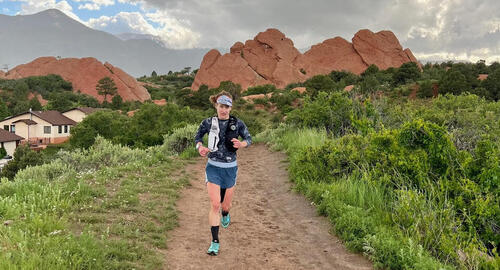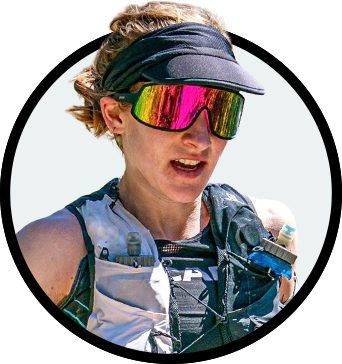As ultrarunner Robbie Britton prepares to race the Leadville 100 ultra race for the first time, we asked 2023 runner-up, Lucie Hanes, to share her six top tips for a debutant racing an epic ultra at altitude...
Dear Robbie,
As you prepare to tackle the 'Race Across the Sky', I want to pass off all the insider tips and tricks you need to ensure you have a day that showcases every scrap of your potential.
But I can’t.
There’s no playbook I can write or share. Ultras rarely go according to plan. How could they?
It’s hard enough to anticipate what a cushy day at the office will bring; you might be on track for an early sign-off for the weekend until an impromptu 4pm meeting keeps you desk-bound through dinner. In comparison, running 100 miles through the wilderness is a complete crapshoot. The outcome only becomes more uncertain when every single one of those miles takes place over 10,000 feet (3,048 metres) above sea level.
I don’t say this to scare you. If anything, I hope it gives you some peace of mind. If there’s no secret to acing the Leadville 100, then there’s no pressure to have your strategy down by the time you’re standing on the start line.
I finished as the second-place female in 2023. It was my first crack at the legendary distance, and I have to attribute some of my success that day to beginner’s luck. Sometimes a lack of experience pays off. They say comparison is the thief of joy, but so are expectations. A healthy amount of naivety keeps the mind open to the outcome.
That being said, there’s a difference between going in with an open mind and showing up wholly unprepared. Ignorance isn’t something you want to mess around with during any 100-mile attempt, but especially Leadville. The high altitude nature of this race leaves less room for error than its peers. A little flubbing leads to ingenuity.
Too much, and you’re looking at a DNF on the backend of Hope Pass. Let’s avoid that heartbreak by hitting the sweet spot of advice: just enough to keep you safe and speedy, but not enough to strip you of your creative license.
1. DO your speed work
Ultrarunners love to take the “trial of miles” approach when training for big races. The more time on feet, the better for being prepared to stay on them for 100 miles straight. This much is true. But it would be a mistake to match all of those training miles to the slow and steady pace you plan to maintain for most of the race.
Consider two main reasons that ultrarunners, especially anyone headed to Leadville, should keep up with speed work: economy and power.

First of all, speed work does more than make you faster. Speed also breeds efficiency so that the miles you run (no matter the pace) take less of a toll on your body. Legs that can run fast can also run far. Research on elite long-distance training tactics points to short-distance, high-intensity intervals as one of the key predictors of high performance. The power boost that you get from speed work will also take the edge off of the six brutal climbs that punctuate the Leadville 100.
Besides, there’s no telling when you’ll want to make a power move by revving into a higher gear. I secured my second place spot with a stride into the 50-mile turnaround point that easily could have blown the rest of my race if I’d sacrificed speed for slow and steady mileage throughout the training block. I knew that I could pick up the pace enough to overtake the runner ahead and recover well enough to keep running strong afterward. Few of those around you will have the ability (or the confidence) to do so.
2. DON’T go out too slow
If you’ve done your speed work, then you can ignore another common approach that ultrarunners cling to like a baby blanket: starting out slow. I’m not saying you should sprint off the start line, but consider staking your claim early.
The Leadville course is conducive to betting on yourself from the beginning. A gentle downhill on the asphalt and dirt roads leading out of town begins to narrow into singletrack around Turquoise Lake near mile 10. Getting ahead of the pack before this point will spare you the frustration (and injury risk) of bobbing and weaving through the conga line of runners along the rocky, rooted trail. Once you round the lake into Mayqueen, the route opens up slightly before tightening again as you climb the Colorado Trail. You’ll appreciate some extra space around you during this section as well.
This method carries its risks. Your fellow runners might warn you to ease off the gas after the gun goes off, and for good reason. Leadville will inevitably drain your tank; whether you make it to the finish line before that happens depends on how wisely you use your energy throughout. But I’d argue that creating space around you while the terrain allows it, so you can run your own race complete with bursts and dips in speed as you see fit later on, counts as a wise choice.
Besides, the confidence boost you get from going out strong will stick with you. I know from my background in sports psychology that confidence isn’t something you can create on purpose. It’s a byproduct of accumulating enough evidence of your abilities that you can’t not believe you’re capable. Reflecting on your training block during the taper gives you a chance to count up all the bricks you’ve stacked leading up to the race so you know by the time you toe the line that you deserve to be there as much as anyone else. You can add one final brick with a strong, but smart, start.
3. DO add some variety
Around mile 55, I stopped being able to chew. It wasn’t a problem with my gut or my taste buds, but rather with the mechanics of my jaw. Apparently my body decided to deprioritise that function in favour of... survival, I suppose. Can you blame it?
But frustration preceded sympathy. I couldn’t eat most of the things I had planned on fueling with. This was before my gel awakening, and I considered anything but 'real food' to be a poor health choice. If I couldn’t chew it, it was 'too processed' for me. I’d only practiced with bars, dates and peanut butter pretzels. Suddenly all of those were off the table.
This was the moment that my view on health as an endurance athlete completely changed. I could either DNF after running myself into a massive energy deficit, or I could embrace liquid calories in all their 'processed' glory. Luckily, I had my priorities straight: I would ingest anything to keep me going. Coke, ramen broth and gels saved my race. They likely also saved my health, because 'real food' alone probably won’t provide a high enough concentration of carbs to maximise energy and minimise hormonal damage over the course of 100 miles.
Be prepared for your stomach to turn or your jaw to simply stop working. Practice with a variety of fueling options so you don’t have to take a chance on new foods like I did. And most importantly, don’t turn down the coke at the Space Camp aid station. It’s magical.
4. DON'T forget hydration
Altitude changes the way we process fluid. Common physiological responses to altitude include increased urine production, ventilatory rate, and sweat rate, all of which lead to water loss. Electrolyte imbalances caused by fluctuations in fluid and hormone levels accompany the water loss.
To make matters worse, many people notice reduced thirst at high altitude which makes it hard to rely on bodily cues. The dry air might also cause your sweat to evaporate faster than normal, so you might not even notice how much fluid and sodium you’re losing. The mountains love to play hardball like that.
Given the fact that the entire Leadville 100 course takes place over 10,000 feet (3048 metres), a hydration strategy that takes these changes into account should be a top priority. Drink according to what you know your body needs in terms of fluid volume and sodium concentration rather than how you feel. Intuition won’t cut it.
I had success playing my own 'drinking game' by taking three sips every time I had the urge to stop running (or moving in general). That happened pretty frequently, so it helped me consistently chip away at my bottles. The energy boost I’d get from each sip created a positive feedback loop that kept me sipping between those low moments too.
5. DO get high
That being said, you can’t know exactly what your body needs at altitude without spending time at altitude. We all know the adage: nothing new on race day. That includes your environment. Make at least a few days of altitude camp a non-negotiable part of your training schedule, ideally no more than a month out from race day. That way, both your body and your mind can retain the experience.
I include 'mind' there because running at altitude presents more than just a physical challenge. While some of the discomfort will ease with acclimation, plenty of it won’t. You can’t feel as good at 12,000 feet (3658 metres) as you do at sea level. Half the battle is getting familiar with those feelings and recalibrating your expectations around them.
I like to top off a multi-day altitude camp with as many follow-up exposures as possible between then and race day. My local trails won’t get me higher than 5,000 feet (1524 metres), but I’m lucky enough to have the Grand Mesa about an hour away. Taper weeks make great opportunities to swap out miles for drive time. Since true adaptation takes weeks to sink in, every opportunity for exposure adds up.
6. DON’T lose your groove
I experienced three separate panic attacks within the final eight miles of the race. That’s another thing that, like forgetting how to chew, I don’t blame myself for in retrospect. By mile 92, neither my body nor mind could fathom taking another step. My pace had slowed significantly, and thinking about how long it would take to cover those final miles sent me reeling. Eight out of 100 miles seems like chump change in theory, but in practice it felt just as daunting.
Relief came in the form of rhythm. Every time the panic rose, I came back to my breath. Breathing is one of the most reliable tools we have on hand as humans; it’ll keep happening on its own accord, so it can act as an anchor for everything else that feels completely out of control.
Expect yourself to lose some grip on sanity, especially towards the end. All it means is that you’re doing something that your brain can no longer quantify. When the task feels too big, make it smaller. Find your anchor in something so basic you can’t not do it, like breathing. The rest will play out from there.
